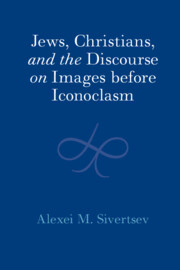Book contents
- Jews, Christians, and the Discourse on Images before Iconoclasm
- Jews, Christians, and the Discourse on Images before Iconoclasm
- Copyright page
- Dedication
- Contents
- Figures
- Preface
- Abbreviations
- Introduction
- 1 Dissimilar Similarities
- 2 Jacob’s Image
- 3 Jacob’s Dream and Relic Veneration
- 4 God’s Impossible Form
- 5 Articulating the Impossible
- Conclusions
- Bibliography
- Index
1 - Dissimilar Similarities
Published online by Cambridge University Press: 01 February 2024
- Jews, Christians, and the Discourse on Images before Iconoclasm
- Jews, Christians, and the Discourse on Images before Iconoclasm
- Copyright page
- Dedication
- Contents
- Figures
- Preface
- Abbreviations
- Introduction
- 1 Dissimilar Similarities
- 2 Jacob’s Image
- 3 Jacob’s Dream and Relic Veneration
- 4 God’s Impossible Form
- 5 Articulating the Impossible
- Conclusions
- Bibliography
- Index
Summary
Between the sixth and eighth centuries ce, the image emerged as a rhetorical category in religious literature produced in the Mediterranean basin. The development was not a uniquely Christian phenomenon. Rather, it emerged in the context of broader debates about symbolic forms that took place across a wide range of ethnic, linguistic, and religious groups who inhabited the late Roman and early Byzantine world. In this book, Alexei Sivertsev demonstrates how Jewish texts serve as an important, and until recently overlooked, witness to the formation of image discourse and associated practices of image veneration in late antiquity and the early Middle Ages. Addressing the role of the image as a rhetorical device in Jewish liturgical poetry, Sivertsev also considers the theme of the engraved image of Jacob in its early Byzantine context and the aesthetics of spaces that bridge the gap between the material and the immaterial in early Byzantine imagination.
- Type
- Chapter
- Information
- Publisher: Cambridge University PressPrint publication year: 2024

